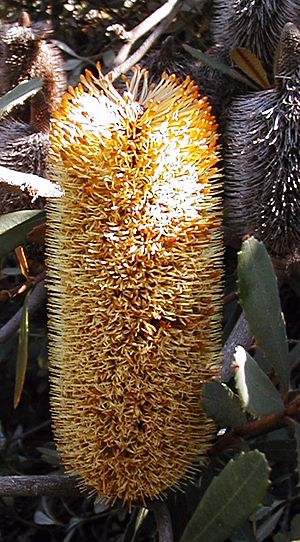Banksia penicillata facts for kids
Quick facts for kids Banksia penicillata |
|
|---|---|
 |
|
| Banksia penicillata in Maranoa Gardens | |
| Scientific classification | |
| Genus: |
Banksia
|
| Species: |
penicillata
|
| Synonyms | |
|
|
Banksia penicillata is a special kind of shrub. It only grows in a small area of New South Wales, Australia. This plant has smooth bark and leaves with jagged edges. Its flowers start as green or bluish buds and then turn yellow, growing in a long, cylinder shape. After the flowers, it forms many narrow, oval-shaped seed pods. These pods stay on the plant, surrounded by the old flower parts.
What it Looks Like
Banksia penicillata is a shrub that can grow up to 4 m (13 ft) tall. It has smooth bark and does not have a special woody lump at its base called a lignotuber. Its leaves grow in circles, like spokes on a wheel. Each leaf is about 35–120 mm (1.4–4.7 in) long and 7–40 mm (0.28–1.57 in) wide. They have a short stem, or petiole, about 5–19 mm (0.20–0.75 in) long.
The edges of the leaves are jagged or deeply cut. The underside of the leaves is covered with soft, white, woolly hairs. The flower buds are green or bluish. These buds open into bright yellow flowers that grow in a long, cylindrical spike. This flower spike can be 70–190 mm (2.8–7.5 in) long. At the bottom of the spike, there are woolly, hairy leaves called involucral bracts, which are 10–20 mm (0.39–0.79 in) long.
The flower parts, called the perianth, are about 20–26 mm (0.79–1.02 in) long. The part of the flower that receives pollen, called the pistil, is 22–26 mm (0.87–1.02 in) long and slightly curved. Banksia penicillata flowers from March to June. After flowering, up to one hundred oval-shaped seed pods, called follicles, grow on each spike. These pods are about 11–15 mm (0.43–0.59 in) long and stay surrounded by the dried remains of the flowers.
Name and History
The Banksia penicillata was first officially described in 1981 by a scientist named Alex George. He wrote about it in a science journal called Nuytsia. Later, in 1996, another scientist, Kevin Thiele, along with Pauline Ladiges, decided it was a unique species. They gave it the name B. penicillata.
The special part of its name, penicillata, comes from a Latin word. It means "like an artist's camel-hair brush." This probably describes the shape of its flowers or some other part of the plant.
Where it Lives
Banksia penicillata grows in a few places in the Blue Mountains area, which is west of Sydney. You can find it on or near rocky sandstone cliffs. It grows in forests and woodlands in these specific locations.
How it Survives
This banksia plant does not have a lignotuber, which is a woody swelling that helps some plants regrow after fire. Instead, its seed pods stay tightly closed. They only open up to release their seeds after a bushfire. The fire kills the main plant, but new plants can then grow from the seeds that are released. This helps the species survive and spread.
Images for kids


